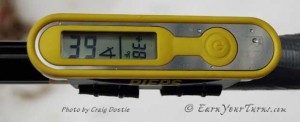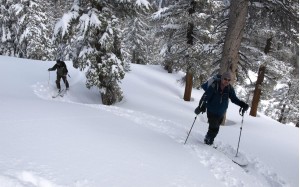If you have reason to measure slope angles accurately, you would be hard pressed to beat the convenience of Pieps 30° PLUS. It’s a small, light device that measures slope angle in any orientation quickly and accurately. How does it work? With some electronic wizardry on a chip that measures gravitational acceleration in three axes. Power comes from a non-replaceable lithium battery Pieps claims will last at least five years. It has no off switch, but conserves energy by only staying on for about 30 seconds each time you turn it on.
Besides being light and mounting to any commercially available ski pole using a pair of Velcro straps I like how I can hold it in any orientation, as long as I can read the display. It was developed primarily for avalanche pros and snow science hounds who want a fast, accurate way to record slope angles. For me, it was the perfect tool for seeing how accurate my estimate was of my preferred Meanderthal skin track angle, and equally as interesting, the average attack angle of the typical guide skin track and Neanderthal skin tracks found on the shores of Lake Tahoe, the Cascades, Rockies, Sierras, Tetons and Wasangeles ranges.Bela Vadasz, who has developed the Ski Mountaineering program for the AMGA says they teach their guides to maintain a track with an ascent angle of around 15 degrees as optimal. I’ve followed the tracks set by many guides and while 15° may be what they are taught, the majority of guides tend to set a track closer to 18°. Only those with glacial experience seem to even know how to hold an ascent line less than 15°. While it may seem like nitpicking to make issue of only 3°, such a different is easily noticed, far more than you would think. It should be noted that 15° tends to be the angle rando racers prefer, allowing an economy of aerobic energy while moving steadily upward for long periods of time. This is the fastest way to travel through the mountains. If it weren’t racers would adopt a different angle of attack.
Myself, it seems my meanderthal tendencies clock in around 13° to 15° for a long climb, with short pitches up to 20° thrown in for variety as terrain demands. This is a step up from the days before free pivots were available to pinheads, and much appreciated. It remains however, noticeably lower angle than racers, and slower, but it shares the long-run advantages. Competitive folk definitely like to log an ascent angle of 20°+ on average, with extended pitches above 25° just to prove they can and followers can’t. I can, but usually won’t. It is worth noting that even the chargers who like setting steep lines will prefer my meandering track if it’s already plowed and, now that I have the freedom of a free pivot I have increased my typical old-man skin angle from 10° to 13°. It doesn’t sound like much, but it is absolutely noticeable.
But I digress. The main reason I like the Pieps 30° PLUS, and you may too, is how fast and easy it is to measure angles. If you know what you’re doing you can estimate angles with your ski poles; not all that accurate, but a quick way to ball park angles if you practice (and know your trigonometry). A popular model featured by several manufacturers uses a ball bearing inside an oil filled cylindrical arch. Fairly fast and accurate, no batteries required, and cheap. Great for patrollers, but recreational skiers will tend to leave such widgets in their pack. The Pieps 30° PLUS give angles within 1° accuracy, and the measurement settles out in about two seconds. Perhaps most important though is how accessible it is. Cinch it to your pole and it’s right there by your hands, ready to be used.
Besides slope angle, in any 3-D orientation, the 30°PLUS also reads the outside air temperature in Fahrenheit or Celsius.
The only thing I’m not too happy about is the fact that the battery isn’t replaceable. If I lose or crack this gadget I’ll be upset, but less so than if I have to spend $100 to replace it because the battery ran out. C’mon Pieps, it can’t be that hard to make the battery replaceable. Otherwise, what a cool tool!
MSRP: $99.95



5 pings
[…] could measure slope angle and, of course, there is a smart phone app for that as well. My fave is Pieps electronic 30°+ inclinometer that straps to a ski pole. It doesn’t double as a phone and can’t surf the […]
[…] could measure slope angle and, of course, there is a smart phone app for that as well. My fave is Pieps electronic 30°+ inclinometer that straps to a ski pole. It doesn’t double as a phone and can’t surf the […]
[…] you’re not ready to pony up $120 for Pieps electronic ‘clinometer that measures slope angle to an accuracy of 1° or a new pair of poles from K2 with an embedded […]